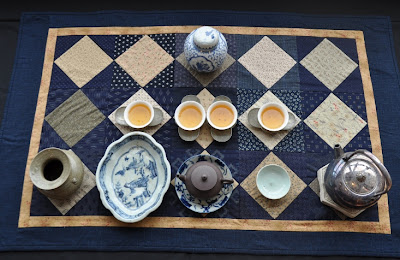 |
| 'Un déjeuner de chasse' de Jean-François de Troy. 1737 (Louvre) |
Mon entrée dans le monde du thé chinois avait été favorisée par quelques cours d'oenologie en France. J'y avais appris les rudiments de la dégustation, l'attention aux plaisirs du palais, les terroirs... Tout cela m'avait grandement servi pour découvrir le thé de manière systématique. Les visites de plantation à Taiwan me rappelaient les visites de domaines vinicoles alsaciens.
J'ai même encore une petite cave à vins chez mes parents en France. A chaque retour au pays, j'en goûte quelques bouteilles (achetées il y a 15 ans et plus, lors de mon départ à Taiwan) pour voir comment elles évoluent. A Taiwan, mes envies de vin sont plus rares. Est-ce du au prix élevé, à l'offre réduite, au temps plus humide et chaud, à la nourriture locale, l'absence de compagnie assoifée de vin ou un mélange de tout cela? J'ouvre surtout une bouteille pour les fêtes ou des soirées mémorables.
Cet été en Alsace, par contre, fut un petit festival de dégustation! Le 26 juillet, je participai à une soirée de dégustation vin et fromage avec 7 vins bio ou en biodynamie. Ils sont le fruit de la sélection d'un
caviste de Haguenau, Jean-Luc Lanoix.
Le déroulement de la dégustation fut intéressant aussi: le caviste nous fait déguster tous les vins à l'aveugle, après les avoir transvasés dans une carafe à décanter. Cela correspond tout à fait au principe de dégustation du thé: on ne boit pas la marque, l'origine ou l'emballage. Ce qui compte, c'est le produit: le vin ou les feuilles de thé. J'ai aussi appris à mieux faire attention à la température du vin rouge. Idéalement, il doit être servi entre 15 et 20 degrés Celcius. (Cela explique qu'il faille bien le refroidir à Taiwan, car il fait souvent bien plus chaud).
Son vin qui nous a le plus dérouté est le Domaine Loew, pinot noir 2012 d'Alsace. Ne buvant que très rarement des vins du Languedoc ou du Rhône, il est normal de ne pas les reconnaitre. Mais la chose est plus surprenante quand il s'agit d'un vin d'Alsace, notre région. Ce vin bio est très doux et clean en bouche. Il représente bien la philosophie de ce caviste: trouver des vins bien faits de grande buvabilité. Il les oppose aux vins de concours, de dégustation, qui vous en mettent plein la vue en quelques gorgées, mais qui sont si puissants et complexes qu'on a du mal à en boire plus d'un verre. Et, effectivement, ce pinot noir coule tout seul en bouche. Il a finesse, élégance et naturel. (Et cela pour moins de 10 Euros la bouteille!) J'y retrouve un des plaisirs des meilleurs thés: un thé si bon qu'on ne le remarque pas au moment de l'avaler, mais qui agit avec puissance et harmonie dans l'after-taste.
J'ai eu une expérience similaire avec un vin naturel d'Anjou, produit par
Cyril Le Moing. Ses vignes poussent sans engrais, sans désherbants, sans pesticides, et ses vins ne sont pas filtrés et n'ont pas d'ajouts de sulfite! Cette démarche rigoureuse et exigeante produit des vins parfois déroutants, qui peuvent évoluer très vite. Je pense qu'ils ont parfois besoin d'un peu de repos après leur mise en bouteille et leur transport. Ceux de 2011, goûtés cet été, m'ont particulièrement plu. Ceux-ci proviennent d'un échange de thé contre vin que Cyril et moi avions fait l'an passé. Je tenais à le remercier de m'avoir permis de découvrir la pureté des vins naturels. J'y trouve de nombreuses sensations communes avec les thés haut de gamme de ma sélection.
























